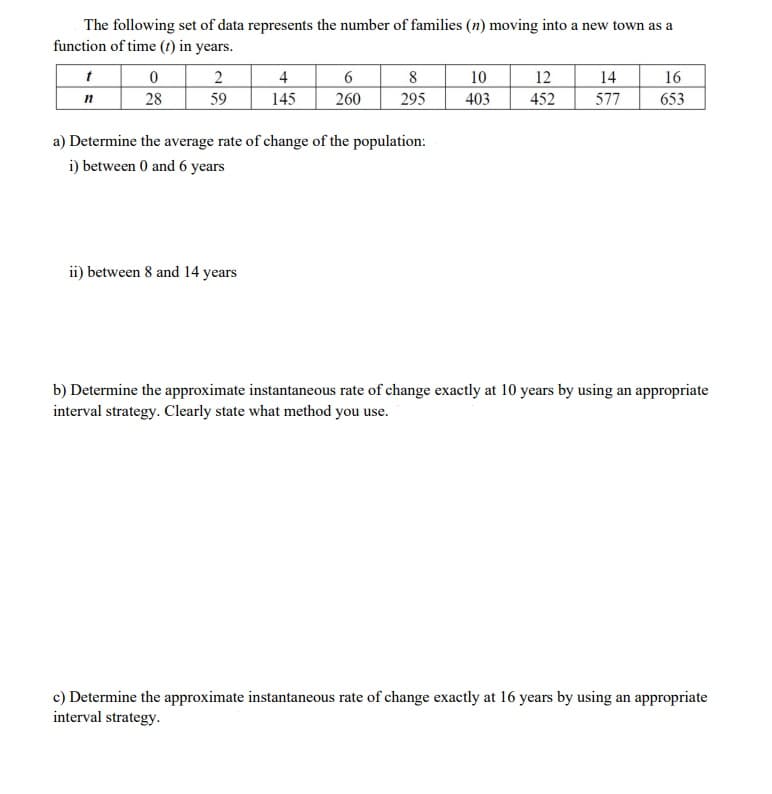The following set of data represents the number of families (n) moving into a new town as a function of time (1) in years. 0 2 59 4 6 8 10 12 14 16 28 145 260 295 403 452 577 653 a) Determine the average rate of change of the population: i) between 0 and 6 years ii) between 8 and 14 years b) Determine the approximate instantaneous rate of change exactly at 10 years by using an appropriate interval strategy. Clearly state what method you use. c) Determine the approximate instantaneous rate of change exactly at 16 years by using an appropriate interval strategy.
The following set of data represents the number of families (n) moving into a new town as a function of time (1) in years. 0 2 59 4 6 8 10 12 14 16 28 145 260 295 403 452 577 653 a) Determine the average rate of change of the population: i) between 0 and 6 years ii) between 8 and 14 years b) Determine the approximate instantaneous rate of change exactly at 10 years by using an appropriate interval strategy. Clearly state what method you use. c) Determine the approximate instantaneous rate of change exactly at 16 years by using an appropriate interval strategy.
Calculus: Early Transcendentals
8th Edition
ISBN:9781285741550
Author:James Stewart
Publisher:James Stewart
Chapter1: Functions And Models
Section: Chapter Questions
Problem 1RCC: (a) What is a function? What are its domain and range? (b) What is the graph of a function? (c) How...
Related questions
Question
Question in Image, Thank you!!!

Transcribed Image Text:The following set of data represents the number of families (n) moving into a new town as a
function of time (t) in years.
2
4
14
6
260
8
295
10
12
16
n
28
59
145
403
452
577
653
a) Determine the average rate of change of the population:
i) between 0 and 6 years
ii) between 8 and 14 years
b) Determine the approximate instantaneous rate of change exactly at 10 years by using an appropriate
interval strategy. Clearly state what method you use.
c) Determine the approximate instantaneous rate of change exactly at 16 years by using an appropriate
interval strategy.
Expert Solution
This question has been solved!
Explore an expertly crafted, step-by-step solution for a thorough understanding of key concepts.
Step by step
Solved in 2 steps with 2 images

Recommended textbooks for you

Calculus: Early Transcendentals
Calculus
ISBN:
9781285741550
Author:
James Stewart
Publisher:
Cengage Learning

Thomas' Calculus (14th Edition)
Calculus
ISBN:
9780134438986
Author:
Joel R. Hass, Christopher E. Heil, Maurice D. Weir
Publisher:
PEARSON

Calculus: Early Transcendentals (3rd Edition)
Calculus
ISBN:
9780134763644
Author:
William L. Briggs, Lyle Cochran, Bernard Gillett, Eric Schulz
Publisher:
PEARSON

Calculus: Early Transcendentals
Calculus
ISBN:
9781285741550
Author:
James Stewart
Publisher:
Cengage Learning

Thomas' Calculus (14th Edition)
Calculus
ISBN:
9780134438986
Author:
Joel R. Hass, Christopher E. Heil, Maurice D. Weir
Publisher:
PEARSON

Calculus: Early Transcendentals (3rd Edition)
Calculus
ISBN:
9780134763644
Author:
William L. Briggs, Lyle Cochran, Bernard Gillett, Eric Schulz
Publisher:
PEARSON

Calculus: Early Transcendentals
Calculus
ISBN:
9781319050740
Author:
Jon Rogawski, Colin Adams, Robert Franzosa
Publisher:
W. H. Freeman


Calculus: Early Transcendental Functions
Calculus
ISBN:
9781337552516
Author:
Ron Larson, Bruce H. Edwards
Publisher:
Cengage Learning